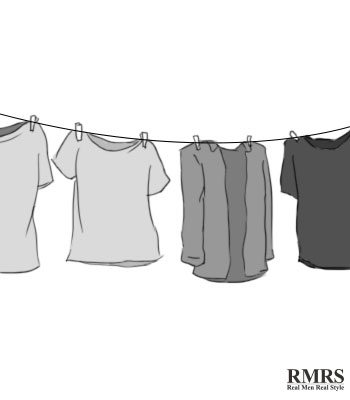You know you've done it — you've brought something that could have been washed at home to the dry cleaner's, just because you weren't quite sure you'd get it right.
There's no shame in turning to the dry cleaners when you need them.

And for a number of garments it's simply the most convenient option — washing and drying a wool suit at home without damaging it is a time-consuming process.
But in many cases, lighter “delicates” can be washed at home safely. It's just a matter of knowing how to treat the most fragile items in the laundry basket.
These tips work for women's clothes as well as men's, so don't be afraid to impress your spouse or girlfriend with some at-home laundry. Their clothes often make up the more delicate half of the laundry basket, and they'll appreciate the help.
7 Tips To Wash Expensive Clothing
Tip #1: Read The Labels

As the internet sidebar ads say, here's one crazy trick most men don't know — your clothing generally tells you exactly how to take care of it.
It's always amazing to talk about laundry with guys (well, all right, getting guys to talk about laundry in the first place is amazing in its own right) and see how many are surprised by the idea of checking the garment tags.
The little mess of words and symbols tells you pretty much what you can and can't do. There are some subtleties worth unpacking — “Dry Clean Only” means just that, for example, while clothes that are simply tagged “Dry Clean” can generally be hand-washed as well.
But in general, if the tag expressly forbids something, don't do it — a big “X” through the little laundry machine graphic means keep it out of anything with a spin cycle, regardless of temperature. “Air dry only” means letting the garment sit in the air, not tumbling it on the “cool” setting, and so forth.
Follow the directions — especially the ones that tell you what not to do — and you'll already have made delicate garment care a dozen times easier.
Tip #2: Learn To Hand Wash
Some delicate fabrics do just fine on the “delicate” cycle in the washer. Most, however, do best when they're hand-washed. Good hand-washing is a simple but important skill. The basic principle goes like this:
- You fill a large basin, tub, or sink with lukewarm water
- You stir in a mild detergent (not a “detergent soap” — use plain detergent, otherwise some garments will get soap stains)
- You gently submerge your garments and then swish them slowly from side to side for about five minutes.
Don't scrub while you're doing this, even at stains, and don't cram too much in at once. There should be plenty of water sluicing around and through the fabric. Change the water every few loads, especially if you're treating badly soiled clothes. You don't want to be washing your last couple loads in dirty water.
Even a full laundry hamper can be done in about half an hour this way. It's not the most exciting task in the world (though it is soothing, in a way), so put on some music or an audiobook or the TV before you get started.
Tip #3: Treat Stains Immediately
Never let a stain sit. Quick pre-treatment can make the difference between a short, effective hand-wash later and a permanent stain.
As soon as possible, wet stains with plain water. Organic stains made from animal proteins (blood, fat, etc.) can “cook” to permanence if you use hot water, so keep it lukewarm or cold for those. Inorganic stains like dirt and synthetic oils can be treated with warm or hot water.
Dab the water onto the stained cloth from behind the stain, and set it face down on a paper towel or other neutral, absorbent cloth — that way the staining substance is leeching naturally off the surface of your garment, rather than soaking deeper into it.
Tip #4: Soaking Never Hurts
If you've got something that's stained, rather than just dirty, soaking it never hurts.
By “soaking” we mean immersing the whole item in water and letting it sit for a while. A couple of hours to a whole day in room-temperature water will give whatever is staining the cloth plenty of time to weaken and break apart, making later treatments quicker and easier.
Be sure the whole garment is submerged. Some delicate fabrics will swell when wet, and you want the fibers to change size evenly, so that they don't warp out of place. As long as the whole garment is wet and then dried at the same rate, you should be fine.
Tip #5: Hand Wash in a CLEAN Basin
The easiest way to clean most delicate fabrics is by hand (we'll go into more detail on how in just a moment). But before you start, make sure the vessel you're using (usually a sink or bathtub) is scrubbed clean with water and a fresh brush.
You want to get rid of stains and mildew, but you also want to get rid of any harsh chemicals you have have used in the past. If there's Clorox clinging to the tub when you fill it, your wash water now contains bleach. That's going to have an unexpected — and unwelcome — effect on your clothing.
Tip #6: Dry Clothing Flat

Delicate clothing, whether it's been hand-washed or washed on a delicate cycle, generally needs to be air-dried. That means “dried by sitting out in the air,” not tumbled in a hot-air drier, and the best way to do that is lying flat.
Some delicate fabrics can be hung on a clothesline just fine, but others will crease where they're folded over the rope. Clothespins can be even harder on fragile weaves, and can leave permanent dimples in the garment.
It can be tough to find enough flat space in a home to lay all your wet clothes out, so hang what you can (sturdy cottons, etc.) and only lay the delicates out.
A clean grate or rack with slots in it that allows airflow underneath the garments works best — dishracks, baking racks, and futon frames are all good low-budget options that you may already have around the home. Just make sure they're clean.
Turn the garments over every half-hour or so to make sure everything dries evenly and doesn't gather mildew. Drying time can range from under an hour to over a day, depending on your climate and space.
Tip #7: Machine Wash Wisely
Not all your delicates need to be hand washed. Most things labeled as “delicate,” “dry clean,” or “hand wash” (as opposed to “dry clean ONLY” or “hand wash ONLY”) can be safely put in a washing machine — as long as you're careful.
The best washing machines to use are ones that do not have a central agitator. That's the big “stalk” rising up from the middle of most conventional in-home washing machines. You can buy ones without the agitator, and many laundromats use larger spinning drums that don't have agitators as well (these tend to be front-loading rather than top-loading — always a good clue).
Using the “delicate” setting on the machine is another obvious aid to gentle washing. If cycles are listed in terms of heat and length instead, go for a “cool” or “warm/cold” or similar setting (not cold, and definitely never hot) and a short wash cycle.
Your goal is to come as close as you can to the experience of swishing the garments around in a big basin, only without having to be there doing the swishing yourself. The further you get from that, the harder it'll be on your clothing.
Delicate items can also be stored in thin, water-permeable washing bags to keep them from snagging on other clothing or internal machinery. It won't prevent staining if you've got dye problems, but it does reduce the likelihood of stretching and tearing.
Finally — because of those aforementioned dye problems — always wash colored items with similar colors. If it's an item's first time through the wash, throw it in on its own, or with something you don't mind staining, just so you can see how badly it “bleeds.” Washing a new item with an old rag is a good test of a garment's dye. If the rag comes out with new colors on it, keep washing that item alone for a while.
Not sure when and how often you can have your suit dry-cleaned?
Check out this article on When To Dry Clean Your Business Suit
The post How To Wash Your Delicate & Expensive Clothing appeared first on Real Men Real Style.
